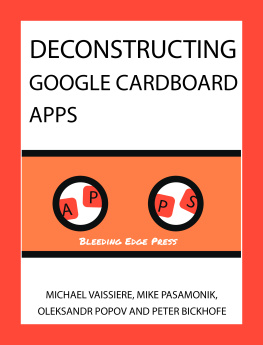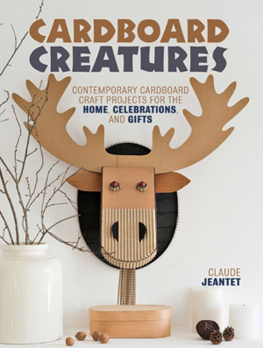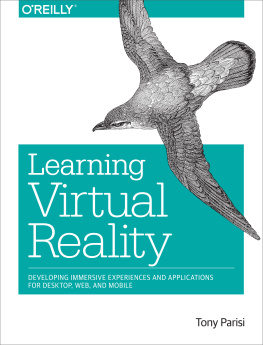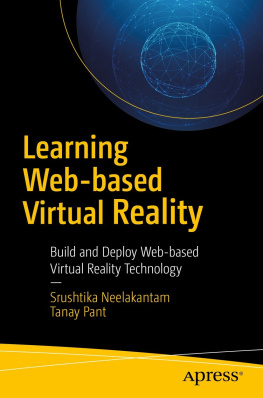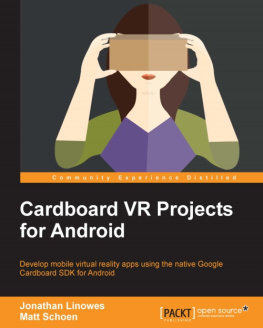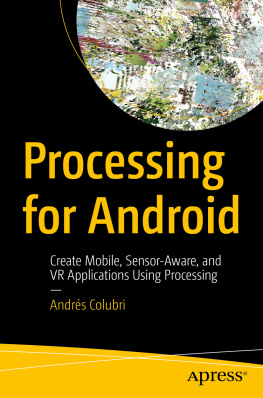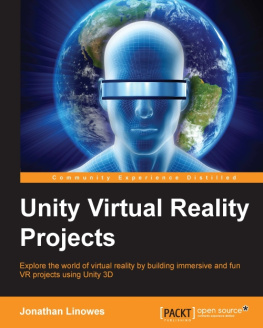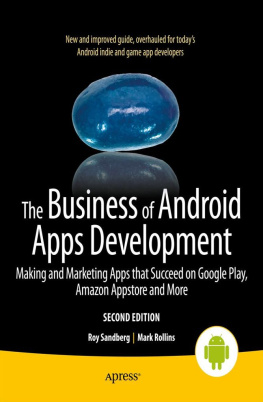This book is aimed at mobile developers with Unity3D experience. The following level of knowledge is helpful to get the most out of this book:
Authors
Michael Vaissiere
Michael Vaissier (aka Ryan Conrad in VR) has been working in IT for the past fifteen years, as a developer, enterprise architect, and a project manager. He is an indie developer creating Google Cardboard apps, creating the popular Alien Apartment VR. He loves crafting worlds, music, and stories and is passionate about science and astronomy.
Mike Pasamonik
Mike Pasamonik is the creator of Glitcher VR. He is a computer science graduate student and a full time software engineer at San Diego State Universitys Language Acquisition Resource Center, where his duties include writing and maintaining web and mobile applications. His primary area of study and interests are in artificial intelligence, computer vision, robotics, and VR.
Oleksandr Popov and Dymtro Popov
Oleksandr Popov and Dmytro Popov are the creators of Lanterns and Villages VR among many other applications. Dmytro is a 3D artist at Axiomworks, Inc. and a software developer at ELEKS Software. He is interested in creating more friendly and playful web design, Web 2.0, JavaScript programming, and cross-platform HTML-based mobile applications. Oleksandr is a PM, Developer at ELEKS Software.
Peter Bickhofe
Peter Bickhofe is the creator of WAA! When Asteroids Attack! He is a Game Developer, and is interested in Unity3D, VR, Location Based Gaming, and is the CEO of HighscoreBrothers.
Technical Reviewers
Raka Mahesa is a game programmer for Chocoarts (http://chocoarts.com/), a small game studio that creates games for mobile and PC. He is responsible for building new technology for the games that the studio is working on, whether its networking, creating a map editor, or even integrating VR. He also creates his own personal games in his spare time and is currently interested in VR since he believes it will play a big role in the future.
Scott Harber has been in the video game industry for almost 12 years, serving as a Technical Artist on titles such as Burnout 3, Need for Speed Hot Pursuit, and Battlefield Hardline. In 2014, he became an indie developer, where he worked on games for mobile, PC, Mac, and Wii U. During that time, he developed an interest in VR, releasing a PC game with Oculus Rift support, and also releasing a Google Cardboard app. Regarding the latter, he was the first Unity developer to publicly share re-usable code to reliably support Cardboards magnet button. To this day, multiple apps on the Play Store still run with this code. The app was later featured by Google, following an integration of the Cardboard SDK. In late 2014, he ceased indie development and returned to the games industry.
Casey Borders is professional developer with over 10 years of experience and has spent almost his entire career focusing on real-time, interactive 3D applications or mobile development.
Raul and Eduardo Acosta specialize in the creation and optimization of immersive environments and graphics for virtual reality and AR for a wide range of devices at Raiz (http://raiznewmedia.com/). They love to move and create graphics, experiments and exploring new ways in design environments for the incoming Virtual Reality.
Chapter 1. A VR Introduction
I decided to buy Google Cardboard last winter because I already had fun with some 360 video applications (long before YouTube support) and thought it ought to be even more fun to add some depth into this thing.Doing it myself? Well...you have to buy the lenses anyway! So, I decided to be lazy. The day the package was shipped, I opened it, built it (five minutes), downloaded the official Google Cardboard application, inserted the phone, and...it was not working until I figured out that the NFC tag had to be there for some reason (at that time the application kept looping a video until the tag gave the NFC detection). Then, I turned on the NFC and inserted the phone again.
The WOW! effect
This is something you will hear from many people. The first time you gaze inside of the cardboard you roar a true WOW! I think it is mainly because of the surprise. At least it was for me. I was so far from expecting that two cheap lenses and a few gyroscopes would really bring the world of VR into my house. But it did. You see depth. You see things in the direction you look at. As unexpected as it is truly VR, people say WOW!.
The Huh effect
And then, a quarter of an hour passed. A quarter during which I tested 3D videos in YouTube, watched Windy day twice, and looked for a few places in Google Earth. Then I said to myself, Okay, thats cool but looking is not enough! I want to explore, I want to interact and I want to move just like I do in real life! So, here I am, thinking that the Google Cardboard official application is probably just a demonstrator, that the thing is so cool and that there must be plenty of content in the Play Store, but to my surprise, there was not. Whats even worse is that after downloading all of the VR applications that seemed to have potential, I quickly came to the conclusion that none of them would ever let me move, or at least not without a Bluetooth controller.

